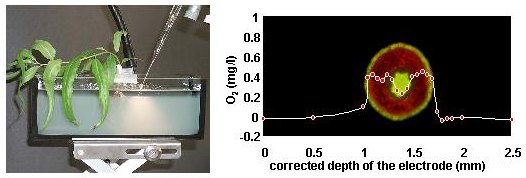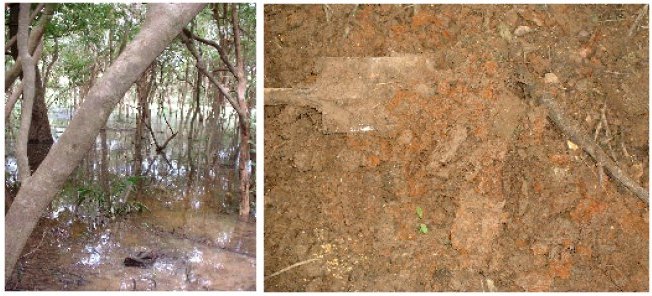|

Morphological adaptations:
the role of gas spaces and suberin
Under anaerobic conditions,
some of the trees under investigation show morphological responses to prolonged
flooding, such as formation of adventitious roots, the presence of air
spaces in the root cortex, and the development of apoplastic barriers in
the root exodermis or hypodermis. Our findings suggest a direct relationship
between the suberization of the roots and the leaf shedding behaviour.
For example, the deciduous tree species lack the ability to develop suberin
deposits in the root hypodermis of young growing root tips. The chemical
composition of isolated hypodermal cell walls is object of recent investigations
in co-operation with the University
of Bonn, Institute of Botany.

Oxygen deficiency and
energy status: alternative energy metabolism
The capacity to withstand
anaerobic conditions requires flood response mechanisms which aids to maintain
the energy level for cell metabolism and nutrient uptake. Under hypoxic
conditions, respiration is restricted and the maintenance of cellular energy
metabolism is mainly achieved by fermentation. The effect of hypoxia on
the adenylate energy charge (AEC) and changes in the expression of respiratory
and fermentative enzymes are investigated in trees which are subjected
to long flooding periods. Ethanol produced in the roots under hypoxic conditions
by fermentation is transported to the leaves via the transpiration stream
in the xylem, oxidized, and subsequently emitted as acetaldehyde via the
stomata. Emission of acetaldehyde and other volatile organic compounds
(VOCs) by trees in response to flooding is studied in cooperation with
the Max-Planck-Institute of Chemistry,
Department of Biogeochemistry .

Rhizosphere conditions:
oxygen as a detoxifying compound
Quantification of oxygen
levels within the roots and the rhizosphere is performed using oxygen electrodes
in agar-embedded plants. In flooded soils, reduction of radial oxygen loss
(ROL) is of adaptive value, since it enhances longitudinal diffusion of
O2 and, in turn, allows for a higher respiration rate of root cells. Investigations
on the oxygen distribution in the roots and the rhizosphere of the aerenchymatous
species S. martiana showed that the radial oxygen leakage out of the roots
was able to create a several millimetre thick oxygenated zone around the
roots, suggesting a role of ROL in detoxifying reduced phytotoxins in the
rhizosphere. These investigations are carried out in co-operation with
the Max-Planck-Institute
for Limnology, Tropical Ecology Group.

Phytotoxins: what to do
with divalent iron
Cellular iron homeostasis
has to be strictly controlled in order to prevent iron deficiency or toxicity
when the extracellular concentration of iron varies. In flooded soils,
due to the decrease in soil redox potential, extracellular iron can reach
phytotoxic concentrations by reduction of insoluble Fe(III) oxides to Fe2+.
Excessive and uncontrolled uptake of Fe2+ leads to toxicity symptoms such
as blackening of root tips, inhibition of root growth, root flaccidity
and necrotic spots on the leaves (`bronzing´). These deleterious
effects are mainly attributed to oxygen stress induced by free radical
generation through Fenton chemistry. Our investigations focus on morphogenetic
and endogenous mechanisms that help to avoid the build-up of toxic iron
concentrations in the plants when subjected to high Fe2+ levels.
|





